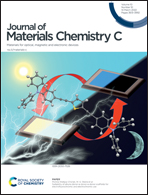Anisotropic mechano-adaptive cavitation in elastomers for unclonable covert–overt anti-counterfeiting†
Abstract
Mechano-responsive structural coloration is especially valuable for information encryption due to the convenience of visualization and the simple authentication procedure. Here, a class of anisotropic photonic polydimethylsiloxane (PDMS) elastomers are reported to change their transparency precisely in response to directional mechanical stimuli. The elastomer can be facilely fabricated through one-pot curing of commercial PDMS precursors containing water droplets as evaporative templates under the stretching conditions. Switchable creases are formed in the obtained elastomer, which would open under mechanical stimuli from particular directions alternating the optical properties of the sample. The mechano-sensitivity and the direction-selectivity can be tuned by altering the structural parameters of the elastomer and its fabrication procedure. It is demonstrated that such elastomerS can be used as covert–overt anti-counterfeiting devices in which complicated labels are encoded by the three-dimensional (3D) localization of the creases into the elastomer. High-level security is obtained due to hierarchical authentication mechanisms, including the transmittance changes at the macroscopic level and the formation of unclonable micro-cavity structures at the microscopic level. This photonic elastomer is thus expected to be very useful in anti-counterfeiting.



 Please wait while we load your content...
Please wait while we load your content...